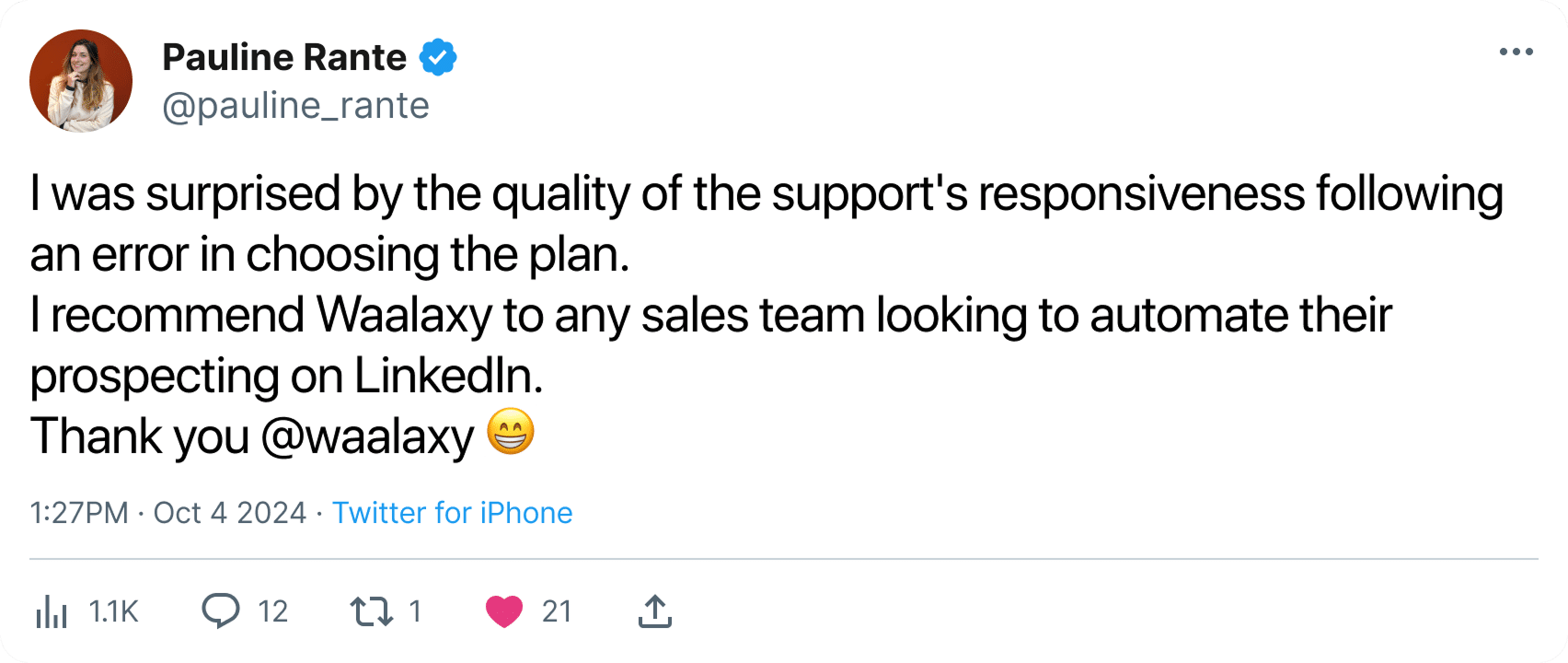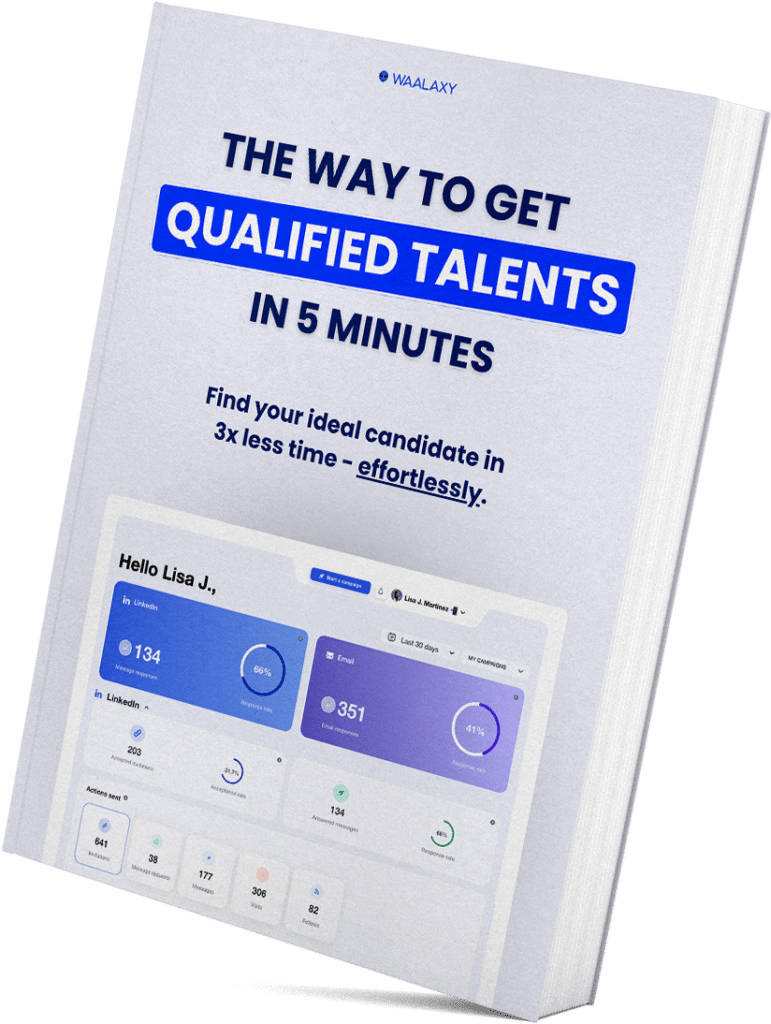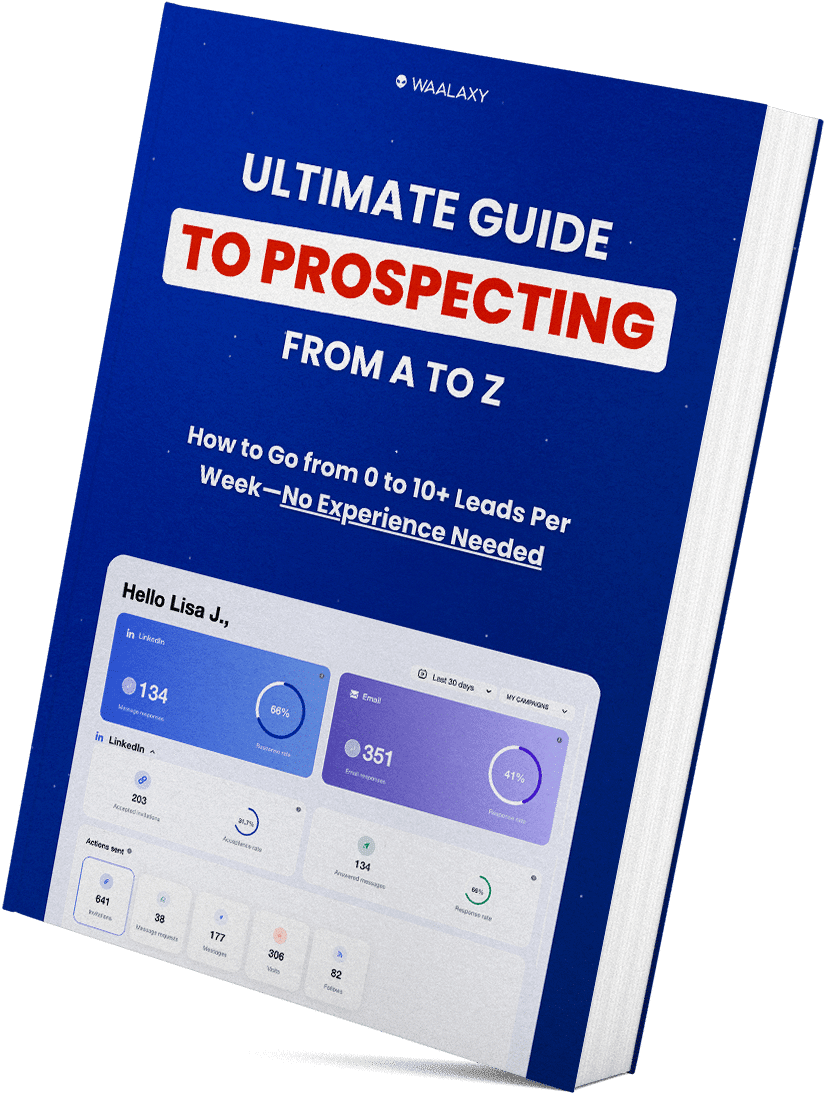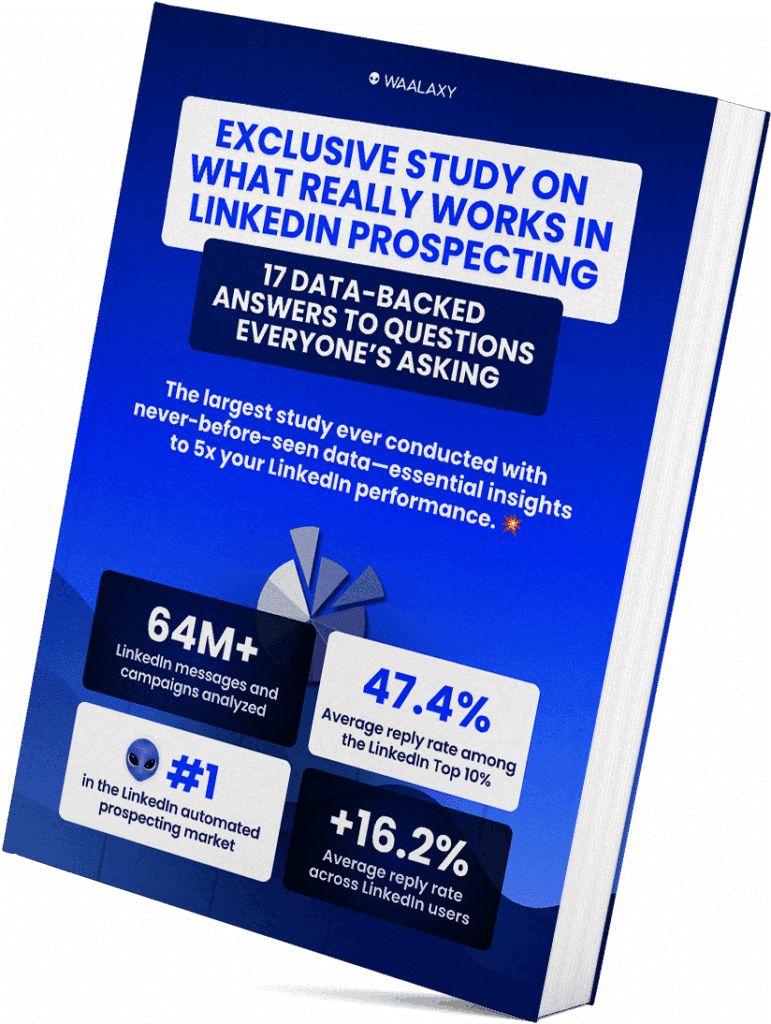Launch your startup is like jumping into the void with a healthy dose of enthusiasm… and a fair few illusions too. You think you’re going to break everything, that you’ve got THE right idea and that all you have to do is work hard to get it off the ground. But, in reality, it takes … a lot of mistakes. 🥲
Toinon Georget, CEO of Waalaxy, is no exception. At the age of 21, he launched his first company right in the middle of his studies. He went on to make all the classic first-time entrepreneurial blunders. 🙃
Today, I’m sharing the 21 mistakes he made when launching his startup and how to avoid them! 👇🏻
Launching a startup: The product and the market
Before you even think about “raising funds” or “scalability”, there’s one thing you can’t afford to miss: your product and your market. And this is precisely where Toinon, like many start-up entrepreneurs, made his first big mistakes. Too many ideas, not enough listening and a desire to solve everything at once ✨
Mistake 1: Wanting to do everything at once
When he launched Waapi, he wanted to digitalize the entire camping experience. From online check-in to activity bookings, from inventory photos to the campsite social network…🏕️
« We had an app that did everything… but everything wrong. »
The problem? In trying to meet all needs at once, no feature was really finished. It’s the classic“Swiss Army knife product” mistake: You want to do too much, you lose focus, and in the end, you don’t solve any real problems for your target. 🎯
Mistake 2: Not focusing on a key problem
He wanted to please everyone. Result: nobody recognized themselves in the product. 🙃
« We weren’t solving a key problem for the campsite manager. »
When they showed the app to campsite managers, each one reacted to a different feature. One would say “your social networking part is nice, but it’s missing ”that”, another would say “ah, but I’d need that”… in short: nobody could find what they were looking for. And for good reason: the product wasn’t focused on a clear need. ✨
Moral of the story: if you want to sell, start by solving a real problem. Not ten little “symptoms”. Just one. But thoroughly. 🔍
Mistake 3: Believing that competition is a problem
He spent his time scrutinizing what others were doing. And every time a competitor launched something new, he told himself he had to do the same. 💻📊
« As soon as a competitor released a feature, we wanted to copy it. »
Except instead of focusing on their product vision, they ended up wanting to look like everyone else. And when you want to look like everyone else… you lose what makes you different. Result: the product went completely astray.😢
Toinon puts it bluntly: initially, you don’t give a damn about the competition. There are always underserved people, curious or some who don’t even know about the solutions already in place. Better to focus on them than waste time copying others. 🚫📋
Mistake 4: Never talking to customers
He spent months developing… without leaving his house. Literally. And it wasn’t until it was time to show the product to prospects that the real galleys appeared. 😅
- “Do you have a sync with my CRM?”.
- “I’m in a white zone, do you have an offline mode?”.
« We spent a year coding in our bedroom. Never talking to anyone. »
Nope. Nothing like that. Why not? Because they’d never taken the time to talk to customers. 😬 Talk to your users as early as possible. Otherwise, you run the risk of building something that looks cool… but is useless.🥲
Mistake 5: Thinking you know the customer better than they do.
« Today, I’ll start by talking to the people I want to sell to. »
The mistake he points out here is believing that you already know what people need. Spoiler: that’s wrong 9 times out of 10. 🤓
He explains that he should have done what a therapist does: ask questions, dig, listen, understand the real breaks, the frustrations, the existing solutions that don’t work. That’s what gives the right insights. That’s what creates a product or service that sells.💥
Want to sell? Don’t start by building. Start by listening.👂🏻
Launching a start-up: The ecosystem
When you set up your own business, you quickly find yourself in a world of its own: incubators, competitions, public aid, press articles, support from all sides… It may seem flattering, reassuring, pro.🤗
But, in reality, all this can also waste an awful lot of time and disconnect you from what’s really important: your product and your customers. Here’s what Toinon has learned. 😅
Mistake 6: Believing that the ecosystem will help you succeed
« At the end of the day, you’re the only one driving your business forward. »
At first, he thought all these people were going to help him build his business. Incubators (like French tech) give the impression of being well-supported. The government injected money. Major groups organized “innovation” competitions with investors/business angels. Everyone said they were committed to startups. 🧑💼🤝
But the reality is that everyone is playing their own game.
- The big groups? They want to improve their image ✨
- Government ? It wants to showcase a high-performance startup nation.📈
- Incubators? They need to show that they “accompany” beautiful boxes.📦
And if we have to be very clear: if your box sinks, no one will come to save you.🥲
👉 Result: You feel like you’re moving forward, when in reality… you’re treading water.
Mistake 7: Drawing up a 40-page business plan… for nobody
Toinon recounts how he spent three weeks locked away in his room writing a complete business plan : market study, financial forecasts, growth scenarios, 5-year projections… Everything he’d been told to do.😇
👉 Except in reality:
- At this point, you don’t even know what you’re going to do next week.📆
- No one actually reads your document (except maybe your banker, and even then,).👀
- Meanwhile, your department isn’t moving forward. You’re not talking to anyone. You’re not selling anything.🛍️
His advice: if you really need this doc (to lift, get help or reassure a partner), get someone else to do it. A freelancer, an accountant. It’ll be done better, and you’ll stay focused on the field.
Mistake 8: Winning competitions… that are pointless
« We were very good at pitching… so we won. »
They won several competitions with Waapi. The pitch was well honed, and they knew how to sell their concept. The problem? No one in those contests was their customer🙃
He says something very right: “It’s super easy to convince people who don’t know your market that you do.” You explain a problem, tell them about your solution… and boom, you’ve got a price. 🎤🥇
But, in real life, that doesn’t advance your business.
- You’re not building anything 🏠
- You sell nothing 🌟
- You spend energy filling out files… for a gain that is often ridiculous.😒
👉 Summary: it mainly boosts the ego.
Mistake 9: Relying on help instead of selling
« We had raised €100,000 in subsidies… and as a result, we weren’t making any sales. »
This is one of the points he criticizes most: the false comfort created by subsidies. They obtained public schemes, zero-interest loans, subsidies… which enabled them to live for several months without really selling.🧐
And that’s the trap: as long as you have money in your account, you can say “it’s ok”. You don’t need customers right away. You’re putting off the moment of truth. 😬
But then it happened: the end of the subsidies. And there, no more choice. You had to generate sales, and otherwise it was back home. And that’s when they started doing real business 🤓
Mistake 10: Believing that the press will change everything
When a journalist contacted him to write an article, he was thrilled. He thought it would bring him visibility, customers and business. And then the article came out. And then… nothing. Not one sale. Not one e-mail. Not an effect.🤨
Why not? Because the mainstream media doesn’t reach the right people. In B2B, especially, it just doesn’t work. He’s learned this over time: articles in BFM are good for the ego, but they don’t sign a customer. 📝
Creating a start-up: Building a team
You can have the best product in the world, the best ideas… if you‘re not surrounded by the right people, it won’t last long. People are what make or break a start-up. When you launch your start-up recruiting or partnering, it’s not done lightly. ✨
Mistake 11: Joining forces for the wrong reasons
It’s a mistake to associate with someone just because the feeling is right.
Back then, there were two of them. They’d been working in campsites, they had a good idea, they wanted to set up a business… so they started up together. Logical, no? Except that setting up a business together isn’t’ t like going on vacation. You spend 10 hours a day with the person. You experience pressure, fatigue, doubts, failures… If you’re not aligned, things explode.💥
And what’s often missing is mutual admiration. Toinon says:
“You have to work with people you admire. And who admire you back.”
Without that, there’s frustration, tension… and often, break-ups (legally complicated ones at that). Partner with people you deeply respect for what they do. And who respect your work as much as you do theirs 🤩
Mistake 12: Believing that taking on free interns is profitable.
On paper, it seems practical to run your business with a number of free trainees. But in reality, it doesn’t work (especially at the beginning). These trainees expect us to train them, to guide them. And that’s normal. But when you’re a small team, you don’t have the time or the structure to supervise them properly.
👉 Result:
- You spend an inordinate amount of time managing them.⏰
- They don’t have the necessary autonomy.👶🏻
- In the end, nobody really wins.💸
A good recruitment is better than three free “” profiles. It’s better to invest in someone who is motivated, competent and whom you can empower from the outset. ✅
Mistake 13: Thinking that being an entrepreneur means knowing how to manage
« Being an entrepreneur and being a manager are two different skills. »
It’s a point that many underestimate (and Toinon is the first):
knowing how to execute, sell, code, launch a project… does not mean knowing how to manage a team.👯♀️
And yet, very quickly, a company’s success depends on the people it brings on board. If every manager isn’t trained, aligned and capable of helping others grow… the machine will eventually grind to a halt. As soon as the company started to grow, he realized that his “skills as an executor” were no longer enough. He had to learn to listen, delegate, manage and motivate. 💪🏻
As soon as your fledgling company has the means, invest in improving your management skills. This is an enormous lever for growing from 5 to 15, then 30 people… while maintaining a healthy HR culture .🌟
Mistake 14: Recruiting because “it could be done”
When someone seems nice, motivated and “full of potential”, it’s tempting to integrate them into the team. But if you don’t have a precise need, it quickly becomes unclear. And in a startup, vagueness is expensive💰
Each person needs to solve a concrete problem, with a clear, measurable mission. Recruiting “just in case” or “because someone is needed” often leads to more confusion than efficiency. Feeling is not enough. Recruit when you know exactly why.🤓

Launching a start-up: Operational mistakes
When you launch a company, you often think you have to “ do what the big guys do”: create a neat structure, organize recruitment, take part in events, make yourself visible… But in reality, it’s often these “logical” decisions that waste time, energy, and above all, take you away from the essentials. 😌
Mistake 15: Creating a legal structure too early
When you set up a business, you think that the first step is to create a company. You start thinking about legal statutes, opening a business account, looking at the different types of companies, and then you start worrying about responsibilities and percentages of shares…🤯
But Toinon explains it very simply: as long as you don’t have a customer, there’s no point.
What you need to do first is test. See if anyone is willing to pay for your idea. And for that, you don’t need a law firm or SAS status. All you need is a simple invoicing solution, auto-entrepreneur status or even… a slightly cobbled-together demo.😉
The administrative side comes later. What counts at the outset is: is anyone ready to get out their credit card? 💳
Mistake 16: Too much unnecessary networking
« You spend your time blowing smoke… but your product doesn’t move forward. »
In his early days, Toinon did what many people do: he went from competition to competition, incubator to incubator, startup event to startup event, network café to network café, pitch to juries…
And he loved it. Because it flatters the ego, it gives visibility, you’re called “promising young entrepreneur”, you’re published in the local press… 🎤📸
But once the euphoria wears off? Nothing. No customers. No finished product. No useful feedback. Time spent networking is time not spent building. Just because you’re everywhere… doesn’t mean you’re getting anywhere.🫤
Mistake 17: Managing with too much negative feedback
When you start up a company, you want to get things done quickly, get everything right, optimize every detail. So you spend your time correcting, pointing out what’s wrong, saying “do better”, “that’s not it yet”, “you could improve”.🤔
It’s normal to be asked. But if that’s all you do, you end up breaking your motivation.
Because hearing only what’s wrong is demoralizing. You lose confidence, you’re no longer willing to take the initiative, and you become overcautious. And that’s exactly the opposite of what a startup needs.😥
Feedback isn’t just for correction. It’s also used to encourage, to motivate, to recognize what’s working. Get into the habit of saying “thank you”, pointing out what’s been done well, even if it’s “normal”. 🥰
Launching your start-up: Operational mistakes
When you create a start-up, you want to do well. You want to move fast, structure, recruit and show that you’re making progress. But in the rush, we sometimes take shortcuts… or avoid certain uncomfortable steps.😒
Mistake 18: Offering a free product… for fear of selling out
This is a very common mistake when starting out: not daring to sell. You’re afraid it won’t be “ready enough”, you’re afraid of disturbing people, you’re afraid of rejection… so you take the easy way out: offer your product for free, “the time to get feedback”.😔
But in reality, a free user doesn’t commit. He tests, gives a polite opinion and then moves on. They’ll never tell you if your product is really valuable, because they haven’t paid for it.
👉 The only real validation is when someone agrees to pay, even a small amount. Then you know that what you’re offering solves a concrete problem. Offering your product for free isn’t the same as making it accessible. It often means avoiding the uncomfortable stage of selling. But you have to get there, and the sooner the better😎
Mistake 19: Fear of raising prices
Another classic mistake is setting your price low, or even too low, for fear of scaring away leads. We tell ourselves that we need to stay “competitive”, that we shouldn’t be too greedy, that we’ll start “small” then see later. 😬
But in practice, this reflex can pose two big problems 👇🏻 :
- You attract the wrong customers, who don’t see the value of the product and will cost you a lot of time.🥲
- You undervalue yourself, which can damage your image as much as your profitability.📈
Doubling your prices sometimes simply means doubling your sales without changing anything else. And it means working with more involved, more demanding customers, who see what you’re doing as an investment, not a “bargain”.💸
Offering a low price at the outset can be a good marketing strategy for entering the market. But once your customers are loyal and your brand is well established, raising your prices becomes one of the best levers for growth.📊
Launching your start-up: Bonus tips
Beyond the classic “” mistakes on product, team or sales, there are also those little things that we don’t necessarily think to prioritize… but which, eventually, can really make a difference.😉
Mistake 20: Not thinking “English first” from the outset
« This is an international world. Think of your business in English right away. »
It’s a mistake that many French companies make: thinking local first, thinking “we’ll look at the international side later”.🗺️
But he insists: as soon as you work in SaaS, in digital products, or even in B2B… you have to get into global mode.
👉 Why?
- You can scale faster 🌍
- English-speaking markets are huge 🤩
- And above all, if your product is good, there’s no reason to limit yourself to your department.😎
Mistake 21: Keeping your idea a secret
« The more you talk about your idea, the better. »
It’s a very common mistake among project owners: they’re afraid their idea will be stolen. As a result, they don’t talk about it, keep it to themselves, work in their own corners for months on end…🤫
Toinon says the opposite. And he insists: you have to tell everyone about your idea.
There are 8 billion of us on Earth. So for your “innovative” idea, there are only three possibilities 👇🏻 :
- You’re in the top 0.00001% of humanity, and you’re a genius, the first to think of it.🤓
- The idea already exists, which means that others have had it before you.👀
- It’s already been tried… but didn’t work, which may indicate that the model isn’t viable.🤔
In any case, there’s no reason to keep your idea a secret. Tell everyone about it, all the time. That’s the best way to improve it, test it against reality… and make it grow.🌟
Everyone has an idea. What makes the difference is execution. So talk, exchange, confront, adjust. That’s how you make progress.
How about a recap?
Setting up a start-up as a founder is quite a leap. You learn as you go, often hitting walls… and sometimes wishing you’d known that sooner. 😅
With this list, the idea isn’t to avoid all pitfalls (spoiler: you’ll still make some 😇), but at least to save time, energy… and a few headaches. Keep this checklist in mind, talk about your idea, stay focused on the problem to be solved and above all, keep it simple, test fast, sell early.
Now you know all the mistakes to avoid when launching a start-up!🚀









